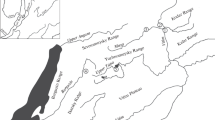Abstract
Thirteen enzyme systems and three nonenzyme proteins were electrophoretically analyzed in red-backed voles of the genus Clethrionomys. In total, 25 loci were interpreted. Gene-geographic variation was studied and indices of genetic variability and differentiation were determined. By the distribution of electrophoretic variants of hemoglobin, C. rutilus was shown to be divided into two geographical groups (northern and southern). A low level of genetic differentiation was revealed in the island isolates of C. rutilus and C. rufocanus. Separation of C. rufocanus, C. rex, and C. sicotanensisinto a superspecies complex was confirmed. A study of differential G- and C-banding on C. rutilus andC. rufocanus chromosomes did not reveal intraspecific variation of autosomes. In these species, karyotypes of voles from Kamchatka Peninsula were studied for the first time. They appeared to be morphologically similar to the karyotypes continental voles by both autosomes and sex chromosomes.
Similar content being viewed by others
REFERENCES
Gromov, I.M. and Erbaeva, M.A., Forest Vole of the Genus Clethrionomys tilesius, 1850, in Mlekopitayush-chie fauny Rossii i sopredel'nykh territorii. Zaitseobraznye i gryzuny (Mammals of the Fauna of Russia and Adjacent Regions: Hares and Rodents), St. Petersburg, 1995, pp. 398-414.
Ota, K., The Murida of the Islands Adjacent to Hokkaido, Mem. Fac. Agr. Hokkaido Univ., 1956, vol. 2, pp. 123-136.
Corbet, G.B., The Mammals of the Palaearctic Region: A Taxonomic Review, London: Cornell Univ. Press, 1978, pp. 97-100.
Aimi, M., A Revised Classification of the Japanese Red-Backed Voles, Mem. Fac. Sci. Kyoto Univ., Ser. Biol., 1980, no. 8, pp. 35-84.
Imaizuni, Y., A New Vole of the Clethrionomys rufocanus Group from Rishiry Island, Japan, J. Mamm. Soc. Jpn., 1971, no. 5, pp. 99-103.
Gromov, I.M. and Polyakov, I.Ya., Voles (Microtinae) of the Fauna of the Soviet Union, in Mlekopitayushchie, Moscow, 1977, vol. 3, no. 8.
Pavlinov, I.Ya. and Rossolimo, O.L., Sistematika mlekopitayushchikh SSSR (Taxonomy of Mammals of the Soviet Union), Moscow: Mosk. Gos. Univ., 1987, pp. 179-183.
Musser, G.G. and Carleton, M., Family Muridae: Mammal Species of the World, Wilson, D.E. and Reeder, D.M., Eds., Washington: Smithsonian Inst. Press, 1993, 2nd ed., pp. 501-806.
Pavlinov, I.Ya., Yakhontov, E.L., and Agadzhanyan, A.K., Mlekopitayushchie Evrazii. Rodentia (Eurasian Mammals: Rodentia), Moscow: Mosk. Gos. Univ., 1995.
Wakana, S., Salaisumi, M., Tsuchiya, K., et al., Phylogenetic Implications of Variation in rDNA and mtDNA in Red-Backed Voles Collected in Hokkaido, Japan and Korea, Mammal Study, 1996, vol. 21, pp. 12-25.
Suzuki, H., Iwasa, N.M., Harado, N., et al., Molecular Phylogeny of Red-Backed Voles in Far East Asia Based on Variation in Ribosomal and Mitochondrial DNA, J. Mammal., 1999, vol. 80, no. 2, pp. 512-521.
Kaneko, Y., Nakata, K., Saitoh, T., et al., The Biology of the Vole Clethrionomys rufocanus: A Review, Res. Popul. Ecol., 1998, vol. 40, no. 1, pp. 21-37.
Yoshida, I., Obara, Y., and Matsuoka, N., Phylogenetic Relationships among Seven Taxa of the Japanese Microtine Voles Revealed by Karyological and Biochemical Techniques, Zool. Sci. Jpn., 1989, no. 6, pp. 409-420.
Mezhzherin, S.V. and Serbenyuk, M.A., Biochemical Variation and Genetic Divergence of Palaearctic Vole Arvicolidae: Forest Vole of the Genus Clethrionomys tilesius, 1850, Genetika (Moscow), 1992, vol. 28, no. 2, pp. 143-153.
Pasteur, N., Pasteur, G., Bonchomme, F., et al., Practical Isozyme Genetics, New York: Hebsted, 1988.
Swofford, D.L. and Selander, R.B., BIOSYS-1: A Fortran Program for the Comprehensive Analysis of Electrophoretic Data in Population Genetics and Systematics, J. Hered., 1981, vol. 72, pp. 281-283.
Seabright, M., A Rapid Banding Technique for Human Chromosomes, Lancet, 1971, vol. 11, no. 7731, pp. 971-972.
Sumner, A.T., A Simple Technique for Demonstrating Centromeric Heterochromatin, Exp. Cell Res., 1972, vol. 75, pp. 304-306.
Kawata, M. and Ueda, J., Protein Polymorphisms and Their Genetic Control in the Red-Backed Vole, Clethrionomys rufocanus bedfordiae, Anim. Blood Groups Biochem. Genet., 1984, vol. 15, pp. 143-150.
Korobitsyna, K.V., Frisman, L.V., and Yakimenko, L.V., Karyotypic and Biochemical Studies of Forest Vole from the Russian Far East, in Populyatsionnaya izmenchivost' vida i problemy okhrany genofonda mlekopitayushchikh (Species Population Variation and Problems of Preservation of the Mammalian Gene Pool), Moscow: Nauka, 1983, pp. 92-93.
Nadler, C.F., Zhurkevich, N.M., Hoffman, R.S., et al., Biochemical Relationships of the Holarctic Vole Genera Clethrionomys, Microtus, and Arvicola (Rodentia, Arvicolinae), Canad. J. Zool., 1978, vol. 56, no. 7, pp. 1564-1575.
Kuryshev, S.V., Soluble Serum Proteins and Hemoglobins of Red and Red-Backed Vole, Genetika (Moscow), 1990, vol. 26, no. 10, pp. 1822-1828.
Velizhanin, A.G., Period of Isolation of North Pacific Continental Islands, Dokl. Akad. Nauk SSSR, 1976, vol. 231, no. 1, pp. 205-207.
Frisman, L.V. and Pavlenko, M.V., Genetic Differentiation during Speciation (on the Example of Rodents), in Voprosy evolyutsionnoi zoologii i genetiki mlekopitay-ushchikh (Problems of Evolutionary Zoology and Genetics of Mammals), Vladivostok, 1987, pp. 4-36.
Frisman, L.V., Kostenko, V.A., Katin, I.O., and Neve-domskaya, I.A., Geographic Allozyme Variation in Clethrionomys rufocanus Sundervall, 1846 and Microtus oeconomus Pallas, 1778 from the Kuril Islands, VI s''ezd teriologicheskogo obshchestva (VI Meet. of the Teriological Society), Moscow, 1999, p. 266.
Geologicheskoe razvitie yaponskikh ostrovov (Geological Development of the Japanese Islands), Mikato Masao, Gorai Masao, and Funakhasu Mitsuo, Eds., Moscow: Mir, 1968.
Graf, J.D., Genetique biochemique, zoogeographie et taxonomie des Arvicolidae, Rev. Suisse Zool., 1982, vol. 89, no. 3, pp. 749-787.
Vorontsov, N.N., Lyapunova, E.A., Ivanitskaya, E.Yu., et al., Sex Chromosome Variation in Mammals: 1. Geographic Variation of Y Chromosome Structure in Voles of the Genus Clethrionomys (Rodentia, Microtinae), Genetika (Moscow), 1978, vol. 14, no. 8, pp. 1431-1444.
Sokolov, V.E., Aniskin, V.M., and Serbenyuk, M.A., Comparative Cytogenetics of Six Species of the Genus Clethrionomys (Rodentia, Microtinae), Zool. Zh., 1990, vol. 6, no. 11, pp. 145-151.
Kawamura, Y., Quaternary Rodent Faunas of the Japanese Islands: Part 1, Mem. Fac. Sci. Kyoto Univ., Ser. Geol. Mineral., 1988, vol. 53, no. 1, pp. 331-338.
Author information
Authors and Affiliations
Rights and permissions
About this article
Cite this article
Frisman, L.V., Kartavtseva, I.V., Pavlenko, M.V. et al. Gene-Geographic Variation and Genetic Differentiation in Red-Backed Voles of the Genus Clethrionomys (Rodentia, Cricetidae) from the Region of the Sea of Okhotsk. Russian Journal of Genetics 38, 538–547 (2002). https://doi.org/10.1023/A:1015595315205
Issue Date:
DOI: https://doi.org/10.1023/A:1015595315205



